Being in Pole position (23.06.09 - 09.07.09)
-
3 weeks ago, I set out on a very strange adventure in the Central European country of Poland - the land of Frederic Chopin, Marie Curie, Pope John Paul II and Robert Kubica. It was going to last 17 days in 3 areas (it's not difficult to find a tour of 8 or more countries in the same time in the Classifieds), so I hoped to get more out of Polska than is possible with a multi-nation tour.
None of the parents I met at work had been there before, and one of my schoolmates had a miserable bunch of photos from a brief stopover, so the only expectation that filled my mind was the sight of the redhead whom I was going to stay with in Warsaw.
The flight to Amsterdam on KLM went without a hitch. Somewhere over Georgia at 0130 Central European time, the sun began to rise.

As we passed over Germany, our flight path became more westerly in direction, and the sun began to set barely 3 hours later.

This is what Lounge 1 of Schiphol airport, Amsterdam, looks like. The prices are as frightening as the rest of Western Europe, so I bought nothing during my 4-hour transit other than an hour of internet - for 6 Euro. There were no bongs but there were plenty of clogs, flowers and Delftware for sale.

-
I arrived in Warsaw after a 2-hour flight from Amsterdam. The plane needed to be bumped back by 2 centimetres because we overshot the aerobridge but it felt more like 2 feet.
 The airport feels one notch better than Budget Terminal - the ceilings were corrugated metal but there was air-conditioning and carpet flooring, and it was clean too.
The airport feels one notch better than Budget Terminal - the ceilings were corrugated metal but there was air-conditioning and carpet flooring, and it was clean too. 
My friend Gosia was there just outside the baggage area (you won't see any photos of her), we grabbed a few maps and brochures from the tourism office and took the Pickpocket Express (Bus No.175) to the city centre. It was bright and sunny after days of endless rain. The temperature hovered around 21 degrees.
After 15 minutes of riding through the suburbs and passing hoardings advertising concerts by Katie Melua, Suzanne Vega and Limp Bizkit, the behemoth came into sight.

This is the Palace of Science & Culture, a "gift" from the Soviet nation to the Polish people in the 1950s. For some reason, nobody refuses gifts from Stalin. It is the tallest building in the city and has become an icon of Warsaw, albeit a painful one that serves as a reminder of the past. Thus, the debate about whether to make it obscure with other skyscrapers never ends. It now has a restaurant, a nightclub, a concert hall and sports facilities, as well as a viewing point at the top.
The bastard is even visible from the street outside Gosia's apartment in the district of Wola. We got there by means of some stale-smelling underpasses around the Palace (they sell kebabs, doughnuts and other things in there) and another bus. You need to put your ticket through the machine just once and it's valid for all the trips (including trams and metro) made in 1, 3 or 7 days, depending on the type you bought.
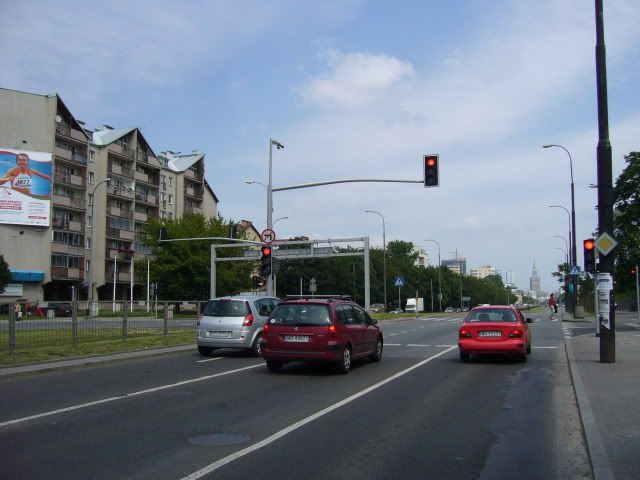
Yep, it's left-hand drive here as well. I had to get used to looking left first before crossing the road, but it makes more sense, as does changing gears with the right hand.
-
After dropping my stuff in the apartment, it's time to have lunch, or dinner in Polish terms. Off we go to Nowy Swiat, a fashionable 19th century shopping promenade with lots of cafes.

We ate in a milk bar where the food is impossibly cheap because it's partly subsidised by the state. Standards are canteen-like and just edible, but what do you expect when a bowl of tomato soup costs 1,50zl (70 cents), and pancakes (nalesniki) with quark 3,50zl?



We also had strawberries with macaroni, and kompot - a drink made by boiling smoked cherries and strawberries.
-
My friend went home to *try* to write her paper, so I toured a part of the city on foot on my own. Walking north, you can't miss the Copernicus monument on the other side of the street.

And across the street from Copernicus is the Church of the Holy Cross. It was badly damaged during WW2. It also houses the urn that contains the heart of the composer Chopin. I didn't explore the interior today.

More than 95% of Poles are baptised Catholics, but few of them attend Mass and receive sacraments regularly. Even the old folks' attendances dropped after Pope John Paul II died.

Further north, these are the gates to the University of Warsaw. Strangely, the clock plays the tune of Big Ben on the hour.

Next to the university is the St Joseph's Care Church, set up by the Order of the Visitation (Visitandines). This time, I went inside. The interior is one of the few that survived WWII.


A beautiful high altar, multiple side chapels and altars, pillar upon pillar of epitaphs, paintings, a pipe organ and plenty of Baroque gilting and ornamentation... I felt like a sua-ku. There's nothing of this scale in Singapore, and there's more to come on the trip.
-
Next to the church is a park that's home to a statue of the author of 'The Doll', Bolesław Prus.

Take a detour to the west from here, and you'll find the statue of Józef PiÅ‚sudski, the ruler of the interwar republic of Poland until 1935.

It overlooks Pilsudski Square, where the Saski Palace stood until it was razed in WW2. All that remains are 3 arches that shelter the Tomb of the Unknown Soldier.


Going back to Krakowskie Przedmiescie, the equestrian statue of Prince Jozef Poniatowski which used to be in Palac Saski now stands in front of the Presidential Palace.
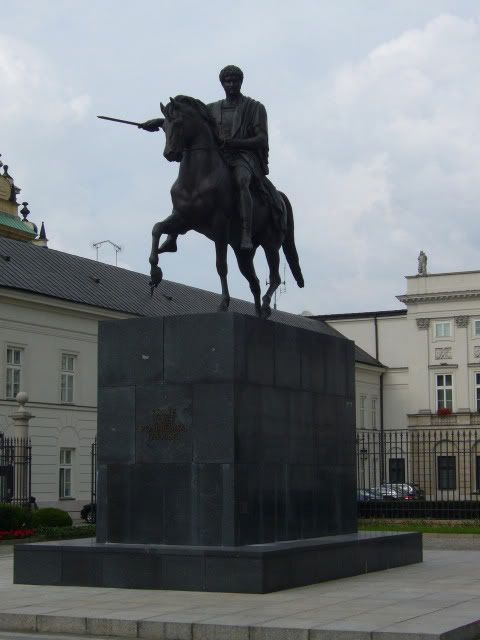
And dominating its own garden is the monument to the poet Adam Mickiewicz.

-
Follow the street and you get to the Carmelite Church...

...followed by the library building, under which are several souvenir stalls. Most of them sell the wooden nesting dolls (Matryoshka in Russian), postcards, little bronze statues, cheap jewellery and things like that.

Here's a shot of the shop buildings that line Krakowskie Przedmescie. Blue skies were fast disappearing so I changed the tone settings on the camera. This street forms the 'Royal Route' that monarchs took when they entered the city.

Castle Square, dominated by the Royal Castle and the Zygmunt III Vasa column, marks the southern entry point of the Old Town. The castle and the town, along with 85% of Warsaw's buildings, were nothing more than a pile of rubble after Hitler ordered the city to be levelled in 1944, and they were rebuilt based on old paintings, photographs and descriptions.

-
Entering the touristy Old Town you're greeted by an incongrous mix of houses with designs from various periods and several Gothic and neo-Classical churches.


The Mermaid of Warsaw (Syrena). One statue of her is by the Vistula river, and the other is here in the market square. As legend goes, she promised to defend the city after some townsfolk saved her from a cage in a merchant's fair.

After you get all the souvenir shops and pubs out of the way, the Barbican, a medieval fortification, separates the Old Town from the New Town, which was were the commoners lived.

The Church of the Holy Spirit looks a lot more impressive than my neighbourhood parish of the same name!

I walked west along this tree-lined street, and after passing some small apartment blocks and shops, the Warsaw Uprising Monument came into view. Polish insurgents of the underground Home Army fought off the Nazis in 1944 (the Allied powers and the Red Army watched on). Sadly they were crushed in 2 months and the order was given to wipe the city from the face of the earth. The 'PW' monogram stands for 'Poland Fights', and it's all over the city in monuments and in graffiti.


Across the street is the baroque Krasinski Palace. Bear in mind that it's now about 6pm and most of the museums, attractions, etc are closed, so I didn't get a look inside.

I took shelter in the Cathedral of Our Lady Queen of Poland when a thunderstorm of Singapore proportions started to lash down. Inside, the walls are filled with plaques and tributes to the fallen. Many were killed inside during the war as it served as a field cathedral cum shelter. In the same way I was protected for a while. I sat in during the Mass and could follow only only at the points when everyone said, 'Amen'.


When the storm lightened up a bit, I made my way back towards Nowy Swiat to meet my friend for supper and a beer. Taking another route outside the walls of the Old Town, there's the monument to the children who served as scouts and carried supplies during the Uprising.

This was the milk bar where we had dinner in the afternoon.
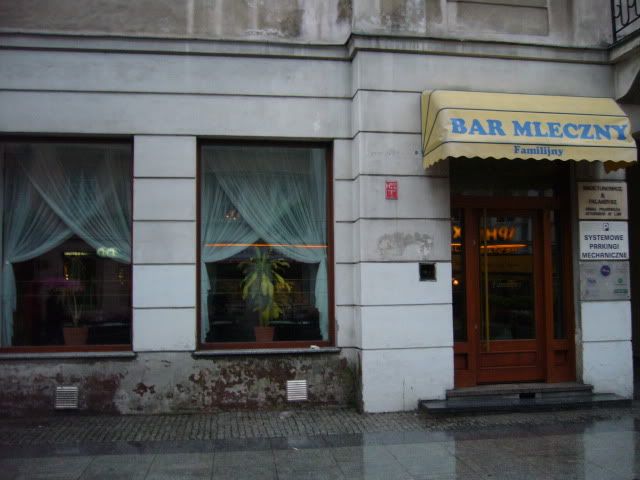
For supper I had kopytka - massive potato dumplings not unlike gnocchi, but topped with meat or sausages with gravy.

And in the pub, we met a couple more friends and had draught Lech beer. It's not uncommon for them to add syrups with flavours like raspberry and ginger to the beer, but mine's unadulterated.
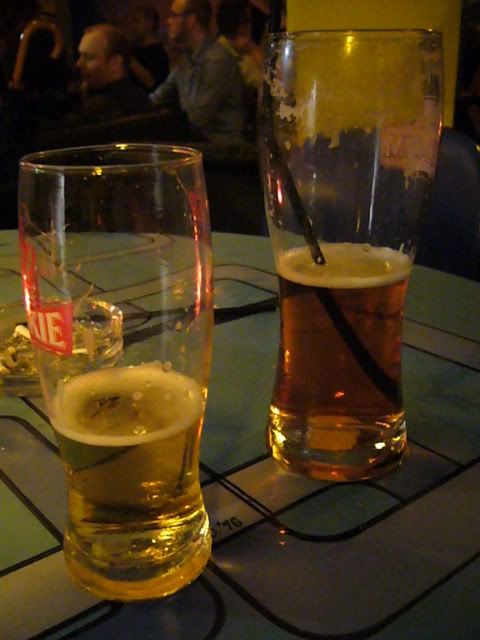
Stalin's present by night - and that'll be all for Day 1.

-
thanks for posting! looking forward to reading more.
-
Very cool KB!
Looking forward to more!
-
Interesting architecture and history.
How about the culture and people there?
-
Originally posted by S.H.:
Interesting architecture and history.
How about the culture and people there?
Folk culture varies from region to region. The people are laidback and reserved. They mind their own business unless you look like you need help or they want to sell you something. English is a tiring language to use but they try to use it if they think it'll help or if Polish doesn't work the first time around.
-
There aren't a lot of photos from Day 2. It was a wet and sodden morning, nevermind that I woke up at 4.30am. Went back to bed and woke up a couple of hours later to catch the intercity bus at Warsaw West Terminal (Dworzec Zachodnia - I have problems with this word, it's DVO-zzhets). Traffic in the morning was slow but at least it was moving.
This leg of the holiday was done on my own, so I left my friend and my suitcase behind in Warsaw. I got on the bus to Mikołajki (Mik-o-WHY-kee) - you can buy tickets in advance or from the driver. Before long, the rectangular apartment blocks of Warsaw's suburbs are far behind and you are greeted by miles of rolling countryside and farmland.

The intercity roads can be very scary. They're only 2 lanes wide and the trees are waiting to catch you should slide off. Very often cars and motorbikes overtake by driving against the flow of traffic, and when there are *proper* roadworks (like ripping up a whole lane of tarmac for replacement), you have to wait for your turn to use the other lane. At other times, potholes are just patched over and it can be a bouncy ride.
The bus stopped for an inordinate length of time in the town of Ostrołęka, so the journey took 5 hours and 30 minutes. A snap of the typical small town before we left:
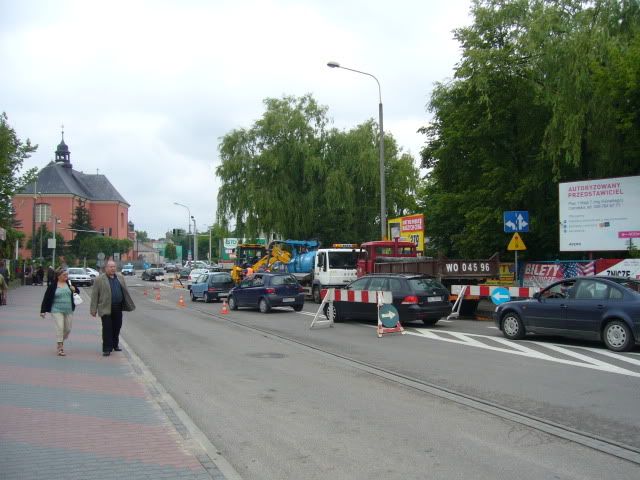
Along the way I chatted with a guy named Bart, and he translated the news that yesterday's rain caused flooding in the Silesia region to the south. We also talked about the people selling mushrooms and berries along the roadside, the Kurpie folks who hold open marriages, the shitty summer and winter weather this year and the village called Zgon, which means 'deceased' in Polish.
We're in the Mazuria region now which has plenty of lakes and interconnecting canals. The skies were still grey when we got to Mikołajki, a popular sailing town in the summer. The bus terminal is actually just a roundabout in front of a former Protestant church. Here's a look at the buildings on the shore of Lake Talty from one of the bridges:

Since I was here for the WRC Rally of Poland, I decided to walk 1.5km to the service park to have a recce myself, and it was as muddy as heck:


No drivers were around since they had all gone to the countryside to recce the routes, aka stages, in unmarked vehicles. We have only 2 manufacturers that are actively involved this season, so on the right are the two Citroen teams (plus 2003 world champion Petter Solberg, who runs an old Citroen in private capacity) and on the left are the two Ford teams and Adapta, which runs last year's Subaru.





You can get a lot closer to the junior and privateer teams because their service areas don't have massive areas of fencing. The contrast in their fortunes is massive - Citroen had 7 giant containers and a media centre, the bigger junior teams a medium-sized container each, and the privateers made do with one or two camper vans for the tools, spare parts and the kitchen!

I stayed at Hotel Zamek Ryn, a 4-star hotel that's some 20km to the north. It was the only place which had any rooms left - and this was when I made reservations 3 months beforehand! It's a former Teutonic knights' castle that is also a museum. 10zl gets you there via bus, or 75zl by taxi. Here's the view of the town, another sailing spot but less popular than Gizycko or Mikolajki, from my room.


I had some wild boar with potato dumplings and a dessert creation called Princess Anne's Dream (3 layers of nut cream separated by biscuits, on top of coffee liqueur). It added up to 70zl sans tips. That works out to about $32 - not bad for a very posh place.


I'll close the day with one of their displays of swords, helmets and other mediæval implements.

-
Kurwa! Why aren't my photos re-sized in Opera browser today?!
-
is the city a cyclist city? do people move around in bicycles or do they rely on trains and buses?
-
That's some trip, Nick! I take it the rally photos will be along at some point?
-
They will come over the next few days.

It's not a country that is conducive for cycling yet and not many people do it. Bicycle paths often start and finish in the middle of nowhere and seldom continue on the other side of the road. Having said that a new bicycle rental network called BikeOne has been set up in Krakow
-
Actually, Wednesday evening, I went to the only bus stop check what time the bus to Mikolajki leaves. A young chap was there with his two female friends, and he called out, "Kolego!" Not knowing what that means, I tried to ignore him and when I left he cussed. Only later did I learn that he was just calling me "mate".
Anyway, to Thursday's action. I left in the morning to catch the shakedown, which is a stage on which the drivers can test car setups as many times as they want within the allocated period. I went to the service park first, which was still as cold, wet and muddy as the day before. Citroen's Dani Sordo returned (the little speck in the background):

Ford No. 1 Mikko Hirvonen, then second-placed in the championship:

Hirvonen's teammate Jari-Matti Latvala:

2003 champion Petter Solberg watches as his mechanics work on the Xsara:

18-year-old Citroen Junior driver Evgeny Novikov

Polish veteren Krzysztof Holowczyc (Ho-WOF-chits) drove a privately-entired Focus WRCar for the event.

Norway's Mads Østberg:

-
Caught sight of Jari-Matti Latvala and Mikko Hirvonen in the service area:


Former co-driver Daniel Grataloup waves back:

5-time and current world champion Sebastien Loeb:

I took a photo with the Rally Radio heroes who deliver live updates on the internet over the weekend when I'm thousands of miles away. I also took a quick snap with Østberg... I was a bit disappointed that his hot girlfriend (Veronica Engan) was not his co-pilot for the weekend.
-
Thanks for all the effort on the commentaries....they helped immensely..
And nice pics! Can see that you had lots of fun.
Looks damn muddy though....
-
Just before I leave for the shakedown proper, Andreas Mikkelsen returns in a privately-entered Skoda Fabia, sans rear bumper:


Got close to Martin Prokop's service area once again, as he prepares to leave:

It's a twenty-minute walk to the spectator section of the shakedown, and people were already leaving because the big teams had already finished their tests. Now it's the junior championship drivers' turn to test. Dutch driver Hans Weijs is already on the way back from his first run:

Another home hero, Michal Kosciuszko:

Here's the shakedown route itself, or at least a corner of it:

Simone Bertolotti:

Kevin Abbring:

Martin Prokop:

You can cross the route unless the marshal's whistle has blown to indicate that a car is approaching:

Video of Loeb going through the shakedown - this spectator point is from 1:20 to 1:33. The actual stages of the rally as actually very fast and flowing but the gravel is soft, so there is less grip and ruts are often left behind.
Radoslaw Typa gets a bit out of shape on the exit of the corner:

Kevin Abbring once again:

I think a piece of gravel caused a microscopic scratch on my camera lens - LOL. Oh, storks are plentiful in the countryside. Sometimes they're so still you wonder if they are statues that people erect for good luck:

-
Citroen hired models to give out flags in the service park. Both teams were trying to outdo each other with the number of goodies they gave out - folders, flags, posters, stickers, etc - and the fans are the biggest winners.


I went back to the town centre to grab some food before the start of the rally in the evening. It's a weekday and the weather was still cold and shitty, so hardly anyone occupied these waitresses:

Plenty of swans in the lake:

And this must be the kitschiest fountain outside Disneyland:

-
nice trip eu hav ^.^
-
The ceremonial start took place at the Superspecial Stage, which was also the venue for Stage 1 (Thursday) and 18 (Sunday). It's a circuit which allows two drivers to race head to head. The stands were packed with Polish fans, about half of them smokers and the other half armed with air horns. Some old cars ran through the stages and it was hilarious because like this Mercedes Benz SL, they were shedding bits and pieces all over the place.


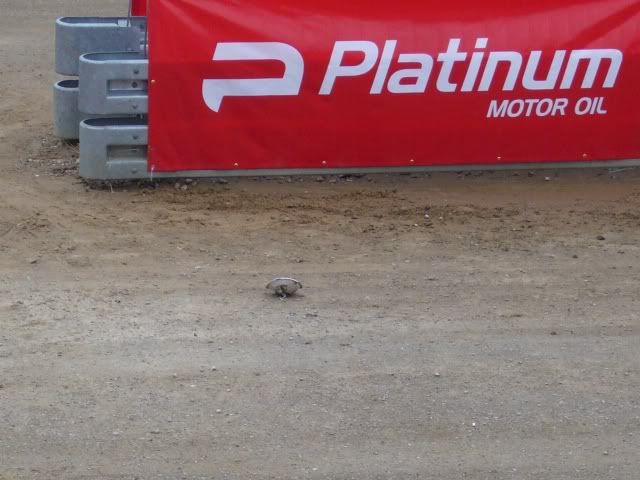
Here's Petter Solberg on the start podium - the drivers drove up one-by-one starting with the privateers and the juniors, and ending with the No. 1 car of Loeb.

Racing head-to-head first to get SS1 underway were Loeb and Hirvonen. Both of them were beaten by Petter Solberg's 7-year-old car however, and he was more than happy to fishtail it and hang from the driver's door. The orange car belongs to Solberg's older brother, Henning:




I left after the WRC cars were done because I was having trouble keeping warm in my seat, so I had supper in the town centre - a buffet for 45zl (about S$20) and it included roast pork knuckles.

-
excellent posts!
look forward to reading more about the trip!
-
keep it coming.